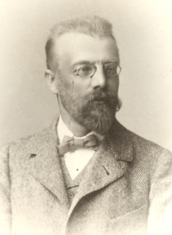Hymn (Sibelius)
| Hymn | |
|---|---|
| Choral song by Jean Sibelius | |
 The young composer (c. 1896) | |
| Opus | 21 |
| Text | Fridolf Gustafsson |
| Language | Latin |
| Composed | 1896, rev. 1898 |
| Publisher | Fazer & Westerlund (1898)[1][a] |
| Premiere | |
| Date | 26 May 1896[3] |
| Location | Helsinki, Grand Duchy of Finland |
| Conductor | Jean Sibelius |
| Performers | amateur male choir |
The Hymn (in Latin: Hymne; in Finnish: Hymni),[3] Op. 21, is a choral song for male choir (TTBB) a cappella written in 1896 by the Finnish composer Jean Sibelius. The piece is a setting of the Latin-language text "Natus in curas ..." by the Finnish philologist Fridolf Gustafsson.
History[edit]
The piece premiered on 26 May 1896 in Helsinki during a ceremony dedicating a memorial stone to Josef Pippingsköld, the late professor of obstetrics at the Imperial Alexander University in Finland (now the University of Helsinki) and member of Finnish Diet; Sibelius conducted a small amateur choir in the old university graveyard.[3]
The ceremony began with a performance of "Integer vitæ", a funereal choral song (1811) by the German composer and medical doctor Friedrich Ferdinand Flemming, which Sibelius conducted. Following this, the university's docent, Gustaf Heinricius gave a tribute that celebrated Pippingsköld's life and accomplishments, and the memorial event concluded with the performance of Sibelius's new choral piece.[4][5] The newspaper Hufvudstadsbladet reviewed Sibelius's Hymn as follows: "The simple opening act was brought to a particularly impressive end by a hymn Jean Sibelius had composed for the occasion in the old Italian style. This did not fail to affect those present".[4]
In 1898, Sibelius made minor revisions to the Hymn.[6] Helsinki's Fazer & Westerlund (Helsingfors Nya Musikhandel) published the revised version in 1898, although this first edition was superseded in 1906 when the German-based firm of Breitkopf & Härtel—having bought Fazer's Sibelius contracts and plates in 1905—issued a reprint.[7] The original, however, is extant, and each version takes about four minutes to perform.[3]
Music[edit]
The tempo marking is Moderato, the time signature is 3
2, and the key is with one sharp. Eventually, the song transitions to a middle section marked Un pochissimo allegro and with no sharps or flats. The Hymn then concludes as it began.
Notes, references, and sources[edit]
Notes[edit]
- ^ On 20 July 1905, the Helsinki-based music publisher Fazer & Westerlund (Helsingfors Nya Musikhandel) sold its Sibelius holdings (the publishing rights and printing plates) to the German firm of Breitkopf & Härtel.[2]
References[edit]
- ^ Dahlström 2003, p. 83.
- ^ Dahlström 2003, p. xxiv.
- ^ a b c d Dahlström 2003, p. 82.
- ^ a b Hufvudstadsbladet, No. 140 1896, p. 3.
- ^ Nya Pressen, No. 140 1896, p. 2.
- ^ Barnett 2007, pp. 106, 120.
- ^ Dahlström 2003, pp. xxiv, 83.
Sources[edit]
- "Statsrådet J. Pippingskölds" [State Councilor J. Pippingsköld]. Hufvudstadsbladet (in Swedish). No. 140. 26 May 1896. p. 3.
- "Invigningen af statsrådet J.A.J. Pippingskölds grafvärd" [The Inauguration of State Councilor J.A.J. Pippingsköld's Gravestone]. Nya Pressen (in Swedish). No. 140. 26 May 1896. p. 2.
- Barnett, Andrew (2007). Sibelius. New Haven, Connecticut: Yale University Press. ISBN 978-0-300-16397-1.
- Dahlström, Fabian [in Swedish] (2003). Jean Sibelius: Thematisch-bibliographisches Verzeichnis seiner Werke [Jean Sibelius: A Thematic Bibliographic Index of His Works] (in German). Wiesbaden: Breitkopf & Härtel. ISBN 3-7651-0333-0.
External links[edit]
- Hymn (Hymne), Op. 21: Scores at the International Music Score Library Project


